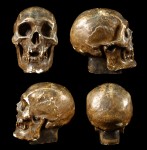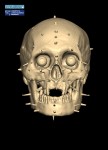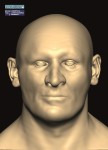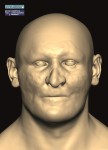 Robert the Bruce, hero of Bannockburn and King of Scots (r. 1306-1329) He died comparatively young, a month before 55th birthday, of an unknown ailment. His body was buried in Dunfermline Abbey where a passel of Scottish kings and queens were laid to rest. The abbey was sacked in 1560 during the Scottish Reformation. The parts of it that survived the sacking fell into ruin. The nave was repaired and used as a parish church until the early 19th century when a new church was built on the site of the Benedictine abbey. Construction workers building the new parish church in 1818 unearthed the bones of Robert the Bruce in a vault underneath what was once the high altar. His remains were sealed in pitch and reburied with great pomp and circumstance, but a cast was made of the skull before the reburial.
Robert the Bruce, hero of Bannockburn and King of Scots (r. 1306-1329) He died comparatively young, a month before 55th birthday, of an unknown ailment. His body was buried in Dunfermline Abbey where a passel of Scottish kings and queens were laid to rest. The abbey was sacked in 1560 during the Scottish Reformation. The parts of it that survived the sacking fell into ruin. The nave was repaired and used as a parish church until the early 19th century when a new church was built on the site of the Benedictine abbey. Construction workers building the new parish church in 1818 unearthed the bones of Robert the Bruce in a vault underneath what was once the high altar. His remains were sealed in pitch and reburied with great pomp and circumstance, but a cast was made of the skull before the reburial.
 There are no reliable contemporary written or artistic depictions of Robert the Bruce’s appearance. He had suffered multiple bouts of serious illness during his lifetime, and some English chroniclers intimated he was afflicted with leprosy. No Scottish reports mention any such affliction. Modern technology could answer many questions about Bruce if his bones were available for research, but they are not. All we have is the cast of the skull of which there are several copies.
There are no reliable contemporary written or artistic depictions of Robert the Bruce’s appearance. He had suffered multiple bouts of serious illness during his lifetime, and some English chroniclers intimated he was afflicted with leprosy. No Scottish reports mention any such affliction. Modern technology could answer many questions about Bruce if his bones were available for research, but they are not. All we have is the cast of the skull of which there are several copies.
 University of Glasgow professor of Scottish history Dr. Martin MacGregor had a brainwave when he saw a documentary featuring the facial reconstruction of Richard III. He realized the technology was advanced enough now that it might work on the cast of Robert the Bruce’s skull in the University’s Hunterian Museum. He reached out to Professor Caroline Wilkinson, Director of Liverpool John Moores University (LJMU)’s Face Lab, an expert in craniofacial identification who created the facial reconstruction of Richard III.
University of Glasgow professor of Scottish history Dr. Martin MacGregor had a brainwave when he saw a documentary featuring the facial reconstruction of Richard III. He realized the technology was advanced enough now that it might work on the cast of Robert the Bruce’s skull in the University’s Hunterian Museum. He reached out to Professor Caroline Wilkinson, Director of Liverpool John Moores University (LJMU)’s Face Lab, an expert in craniofacial identification who created the facial reconstruction of Richard III.
 A careful examination of the cast of Robert the Bruce’s skull does show signs of what could be leprosy. There are osteological changes to his upper jaw and nose consistent with Hansen’s Disease, but the evidence is not conclusive. Dr. Wilkinson therefore took a two-pronged approach to the reconstruction: a younger man in full health, and an older one with scarring from leprosy.
A careful examination of the cast of Robert the Bruce’s skull does show signs of what could be leprosy. There are osteological changes to his upper jaw and nose consistent with Hansen’s Disease, but the evidence is not conclusive. Dr. Wilkinson therefore took a two-pronged approach to the reconstruction: a younger man in full health, and an older one with scarring from leprosy.
Professor Wilkinson said: “Using the skull cast, we could accurately establish the muscle formation from the positions of the skull bones to determine the shape and structure of the face. But what the reconstruction cannot show is the colour of his eyes, his skin tones and the colour of his hair. We produced two versions – one without leprosy and one with a mild representation of leprosy. He may have had leprosy, but if he did it is likely that it did not manifest strongly on his face, as this is not documented.” […]
Professor Wilkinson added: “In the absence of any DNA, we relied on statistical evaluation of the probability of certain hair and eye colours, conducted by Dr MacGregor and his team, to determine that Robert the Bruce most likely had brown hair and light brown eyes.”
“There have also been a number of advances in facial reconstruction techniques since previous depictions of this Scottish hero, including better facial feature prediction and more advanced CGI.”
“This is the most realistic appearance of Robert the Bruce to-date, based on all the skeletal and historical material available.”
This video walks through the facial reconstruction:
This one reconstructs his long-lost tomb, destroyed during the reformation.
If Robert the Bruce “most likely had brown hair and light brown eyes,” why does the reconstruction show him with brown eyes?
The difference in English and Scottish chronicles concerning Robert the Bruce’s affliction or lack thereof should prove an interesting point for a linguistic analysis.
I wonder how much larger and braver and healthier in general Bruce does appear in Scottish accounts 😆
Bits of Robert the Bruce are at the chapel of Saint Serf near Cardross (“viscera”) and Melrose Abbey (heart). Even if they could be found, they’re probably too degraded for a forensic analysis.
After decades of Anglo-scottish and some Irish armed conflict, the 2nd reconstruction might be the more realistic one (despite the observation that his eyes are not ‘brown’ enough, or whatever). Have the royal remains -minus the heart and other viscera- really been plowed -out of reach- underneath of that parish church mentioned above ?
Also, one might wonder what the ’embalming’ did look like. There is on the one hand, what has been classified as the dried-up head of King Henry IV of France, and there were, contrastingly, the led-canned, well-preserved pickled remains of ‘St Bees Man’, who seems to have died in 1368, found in Northern England and ‘uncanned’ in 1981:
“The outer shroud had a tasselled decoration on one end. The flesh of the body was stained and encrusted where it had been in contact with the shroud. But where it had not been in contact, it was of a good pink colour, which faded to a yellowish brown. Except for the fungus on the right leg, there were few visible signs of decay.”
“The arm, when raised, was neither brittle nor soggy. So the doctors made their incisions, and were soon exclaiming: `my, look at that aorta: no heart problems there’. All the internal organs were present and intact. In fact, it took several hours to convince the medical men that this body had not been buried as some kind of medical student’s hoax a couple of days before.”
Hmm. Doesn’t look much like Mel Gibson. 😉
“we relied on statistical evaluation of the probability of certain hair and eye colours, conducted by Dr MacGregor and his team, to determine that Robert the Bruce most likely had brown hair and light brown eyes.”
i.e. we took a blind guess that he might look a bit like modern Scots. Well, except the many with dark hair, gingerish sideburns, and blue eyes.
P.S. Gibson pretended to be Wallace not Bruce.
Honestly, go round some of the older people’s drinking places in Scotland and you’ll see many guys who don’t look a million miles away from the non-leprosy version. How many mistresses and bastards did Robert have? 🙂
Let me rephrase my comment. Gibson wasn’t wasn’t Bruce, he wasn’t Wallace. I trust that is clearer.
Why were his remains sealed in pitch? Would the heat have not destroyed the bones? If not, are they unsealable?
The pitch ? As there was hardly anything left but remains of his skeleton, and therefore to seal or preserve, the motivation to pitch it all under, must have been the fear of another ‘Reformation’ :no:
———–
PS: Aye, we rather fink of some hackit and symbolic, rather Glaswegian ‘tramp character’ (and not at all an impostor !) – C’mon, Ah’m only kiddin ye. Nae need tae take the spur.
She needs to use the same technology to make a new facial reconstruction of Richard III. The only one I’ve seen is almost cartoonish and one of the more amateurish efforts I’ve seen. She’s obviously very skilled with this new technology and did a very good job with this Robert the Bruce reconstruction.
I’m a sceptic about all these reconstructions. The test would be to reconstruct a few faces using these principles and then compare the reconstructions to photos or paintings of the subjects. Obviously the reconstructors would have to work “blind”: they mustn’t have seen any photos or paintings of the subjects or their close relatives.
I’ve never seen a report of such tests. Has anyone here?
Mel Gibson didnt play Robert the Bruce. He played William Wallace
That is because Mel Gibson playes William Wallace not Robert the Bruce 🙁
Mel Gibson played SirWilliam Wallace not King Robert the Bruce.